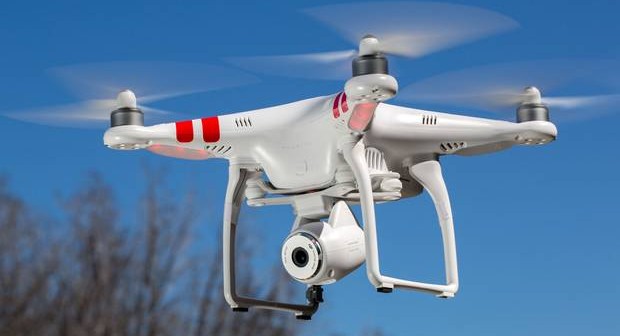PHOTO: “Britain’s measures are inadequate to deal with criminal or terrorist use of drones”
The University of Birmingham’s David Dunn writes for The Guardian:
Dozens of near-misses between drones and manned aircraft took place last year — one drone passing within 25 metres of a Boeing-777 near Heathrow airport, according to the UK Airprox Board, which investigates incidents in British airspace.
Last week the British Airline Pilots Association called for research into the effects of a collision; its safety expert warned that these could include smashed cockpit windscreens and uncontrolled engine failures — in which “you end up with very high-velocity bits of metal going anywhere they like. That could be through fuel tanks, through hydraulic lines and even into the cabin”.
Aren’t there laws to stop this sort of thing? So far Britain’s Civil Aviation Authority has adopted a light touch in regulating drones. Only those that weigh more than 20 kg (44 pounds) or are used for commercial purposes need be registered. Instead, the CAA prefers to educate users through its Dronecode video and the advice to “use your common sense and fly sensibly –– you could be prosecuted if you don’t”.
The rules are straightforward: you should always keep your drone within view, using unaided “line of sight” rather than flying it through the camera, and don’t fly it above 122 meters or beyond 500 meters horizontally. Drones with cameras should be kept 50 meters from vehicles, people, buildings or structure, and users should be mindful not to breach the privacy of others.
In the United States, by contrast, where an estimated 700,000 drones were sold last year, the Federal Aviation Authority (FAA) requires all drones weighing more than half a pound — 227g — to be registered and labelled with an FAA registration number. This followed more than 700 reports of near misses between drones and aircraft, and increased reports of injuries involving hobbyist drones.
The CAA is keen to point out that prosecutions have occurred, as in the case of Robert Knowles, who in 2014 was fined £800 (with £3,500 costs) for flying his drone dangerously close to a bridge in Cumbria. What is less well known is that this prosecution was only possible because Knowles had put his name and phone number on his aircraft.
It is hard to prosecute and thus deter errant drone use unless they are registered and regulated. This might also reduce the risk of accidental misuse of drones by hobbyists. This year, after all, dog owners will be legally obliged to microchip their animals to aid identification, yet the risks presented by larger drones, which have been described as “flying lawnmowers”, are potentially much greater. At the very least the UK should follow the American example in requiring small drones to be registered and regulated, if only to facilitate the legal process that will inevitably follow collisions and injuries from careless drone use.
Better education, more information and warning notices in parks and other open spaces might go some way towards reducing the dangers of drone collisions. A requirement for third-party insurance would also be helpful. But such measures are inadequate to deal with criminal or terrorist use. Any drones that can accommodate a camera can also be weaponized to carry a gun or small explosive device. Their range and anonymity make them potentially ideal murder weapons.
Islamic State already uses drones for surveillance missions and propaganda purposes. Drones have the capacity to fly over perimeter defenses and controlled entry points. If the Paris attackers had armed a drone rather than used suicide vests the attack on the Stade de France might have ended very differently. Drones could be used to attack crowds or target individuals, and such is the novelty of their technology that defense against them is not part of traditional security planning.
It is for this reason that governments and their police and military forces are trying to devise defenses against the small-drone threat. Various solutions have been suggested, such as “geo-fencing” where drones have it written into their firmware (the controlling software) –– that they can’t be used near airports or government buildings. This, though, can be reprogrammed.
It is possible to detect drones through radar or the radio signals used to navigate them – but this is expensive. The technology exists to jam their radio frequencies, hack their controls, or shoot them down. But what happens to the crashing drones has yet to be worked out.
In the nightmare scenario of a swarm drone attack on an airport such considerations would be secondary, but where to mount defenses, how vulnerable aircraft are to such attacks and who should pay for these measures have all to be decided. It is a debate that needs to take place, however, and Balpa’s call for an investigation into the effects of a drone-on-plane collision is long overdue.
The easy access to the air that drones provide is creating many opportunities for leisure and commerce, but a lot more work needs to go into regulating them and defending against their nefarious misuse.

